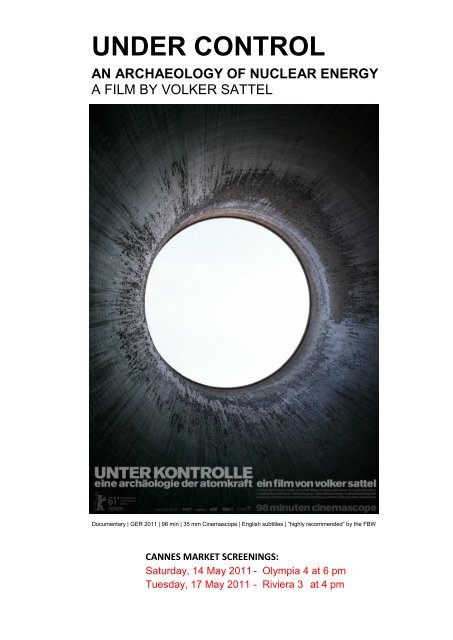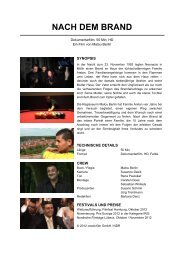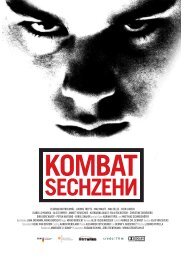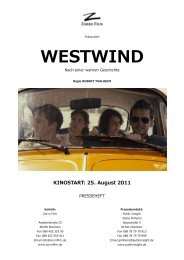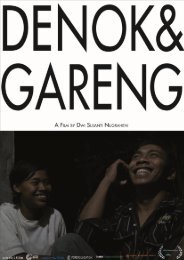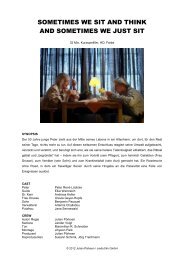Under Control – An Archaeology of Nuclear Energy - credo:film
Under Control – An Archaeology of Nuclear Energy - credo:film
Under Control – An Archaeology of Nuclear Energy - credo:film
Create successful ePaper yourself
Turn your PDF publications into a flip-book with our unique Google optimized e-Paper software.
UNDER CONTROL<br />
AN ARCHAEOLOGY OF NUCLEAR ENERGY<br />
A FILM BY VOLKER SATTEL<br />
Documentary | GER 2011 | 98 min | 35 mm Cinemascope | English subtitles | “highly recommended” by the FBW<br />
CANNES MARKET SCREENINGS:<br />
Saturday, 14 May 2011 - Olympia 4 at 6 pm<br />
Tuesday, 17 May 2011 - Riviera 3 at 4 pm
<strong>Under</strong> <strong>Control</strong><br />
<strong>An</strong> archaeology <strong>of</strong> nuclear energy<br />
<strong>Under</strong> <strong>Control</strong><br />
a Film by Volker Sattel<br />
The <strong>film</strong> starts with a promise. Something glows, vibrates for a moment, builds structures<br />
<strong>of</strong> beauty <strong>–</strong> a “light” that our eye cannot see, the wild heart <strong>of</strong> a technology that has<br />
always had the notion <strong>of</strong> “control” at its core.<br />
If one follows Volker Sattel, taking in the parade in gliding tracking shots, scanning the<br />
objects, buildings and equipment that fall under the term “nuclear energy,” a utopian<br />
project is revealed, right here in our midst, that requires no words <strong>of</strong> explanation.<br />
„<strong>Under</strong> <strong>Control</strong>“ <strong>of</strong>fers the rare opportunity to marvel at this unfinished monument to a<br />
glorious future, as it has not lost its potential to fascinate, despite cracks and dangerous<br />
contradictions. The <strong>film</strong> also reveals the extent <strong>of</strong> the attempts to reconcile this kind <strong>of</strong><br />
science fiction <strong>–</strong> the “peaceful” use <strong>of</strong> nuclear energy <strong>–</strong> with reality.<br />
It is a world explained in small doses, providing insight into the secret life behind the<br />
walls <strong>of</strong> German nuclear plants. We see glisteningly bright control rooms,<br />
decontamination locks, smoke screen devices, enter the depths <strong>of</strong> the mineral deposits<br />
to experience the power <strong>of</strong> superhuman rationality that is supposed to keep the power <strong>of</strong><br />
the particles under control.<br />
Not coincidentally the architecture and the props are reminiscent <strong>of</strong> an earth-bound<br />
space flight. In this world, too, mistakes are not permitted. But since it’s difficult enough<br />
to warm to the notion <strong>of</strong> a journey over decades, the half-life periods <strong>of</strong> radiant<br />
substances are beyond the scope <strong>of</strong> our imagination.<br />
In the end we are left with a sense <strong>of</strong> futility. It’s almost as if we have disappointed<br />
nuclear power, and not the other way around. The miracle <strong>of</strong> this technology is patiently<br />
waiting for a new human being that is more rational <strong>–</strong> and not afraid <strong>of</strong> eternity.<br />
Synopsis: The documentary “<strong>Under</strong> <strong>Control</strong>” unfolds a panorama <strong>of</strong> atomic energy in<br />
Germany. Its broad perspective reveals the real challenges and enormous efforts that<br />
nuclear power demands from humankind. The control over the nuclear fission process is<br />
not depicted chronologically but rather as a prism <strong>of</strong> places and sites that not only<br />
refracts the stations <strong>of</strong> the German atomic age but also reflects beyond the current<br />
situation. The examination <strong>of</strong> a technology once synonymous with progress also touches<br />
on elements <strong>of</strong> the history <strong>of</strong> civilization.<br />
1
<strong>Under</strong> <strong>Control</strong><br />
a Film by Volker Sattel<br />
TECHNICAL DETAILS Running Time 98 min<br />
Format 35 mm, Cinemascope, 1:2,40, 25fps, Color<br />
Sound Dolby Digital<br />
Language German, English<br />
Subtitles English, German<br />
English Title <strong>Under</strong> <strong>Control</strong><br />
Year <strong>of</strong> Production 2011<br />
Country <strong>of</strong> Production Germany<br />
Genre Documentary<br />
CREW Script, Research, Director Volker Sattel<br />
Together with Stefan Stefanescu<br />
DOP Volker Sattel<br />
Camera assistant Thilo Schmidt<br />
Sound Nikolaus Woernle, Filipp Forberg<br />
Sound Design Tim Elzer, Nikolaus Woernle<br />
Mix <strong>An</strong>sgar Frerich<br />
Editor Stefan Krumbiegel, Volker Sattel<br />
Dramaturgy Stefanie Gaus<br />
Line producer Dorothea Seeger<br />
Assitant <strong>of</strong> Prodution Katharina Bergfeld<br />
Producer Susann Schimk, Jörg Trentmann<br />
Comissioning Editors Jutta Krug (WDR),<br />
Sabine Rollberg (ARTE)<br />
© 2011 cred<strong>of</strong>ilm in cooperation with WDR and ARTE. Funded by Kuratorium junger deutscher Film |<br />
Gerd Ruge Award | Filmstiftung NRW and the German Film Fund<br />
2
Filmography (Selection):<br />
<strong>Under</strong> <strong>Control</strong><br />
a Film by Volker Sattel<br />
VOLKER SATTEL , born 1970 in Speyer am Rhein, studied<br />
direction and cinematography at the Filmakademie Baden-<br />
Württemberg in the documentary department. Since then he<br />
realized projects as DOP and director, especially in the<br />
documentary genre and the field <strong>of</strong> experimental feature <strong>film</strong> in<br />
cooperation with Mario Mentrup. Since 1999 he worked as a<br />
private lecturer at the KHM Köln and the HFF “Konrad Wolf”,<br />
Potsdam. In 2008 he was awarded the Gerd Ruge<br />
Projektstipendium for “<strong>Under</strong> <strong>Control</strong>”.<br />
UNDER CONTROL [Unter Kontrolle] Documentary | 98 min | 2011 | 35mm |<br />
Gerd Ruge Stipendiums from the Filmstiftung NRW | Berlinale Forum 2011, Bafici,<br />
Dok.fest München, Jeonju IFF<br />
LEGENDEN Experimental <strong>film</strong> | 30 min | 2008 | 16mm | directed by A. Dubois<br />
2. Award Kurz<strong>film</strong>tage Oberhausen 2010, NRW Competition<br />
RODAKIS Documentary | 12 min | 2007 | 35mm | directed by O. Nicolai<br />
58.Internationale Filmfestspiele Berlin, Forum expanded, Athens Biennal, Toronto 2008,<br />
Vancouver 2008<br />
ICH BEGEHRE Feature Film | 76 min | 2007 | HDV | directed together with M. Mentrup<br />
THEY COME AT NIGHT [Sie kommen nachts] Documentary | 29 min | 2006 | DigiBeta<br />
Transmediale Berlin 2008, Documenta Madrid, Portobello Film Festival London, Int.<br />
Vide<strong>of</strong>estival Bochum, East Silver doc, Sheffield doc festival<br />
LAUFHAUS Documentary | 30 min | 2006 | 16mm | directed by S.Gaus<br />
Duisburger Filmwoche, Kurz<strong>film</strong>tage Oberhausen, Biennale de l’image Geneva,<br />
Documenta Madrid, Festival des Deutschen Films Mainz, Portobello Filmfestival London,<br />
Porn<strong>film</strong>festival Berlin, Fresh Film Festival, Karlovy Vary<br />
AFTER EFFECT Feature Film | 90 min | 2005 | DV | directed by S. Geene<br />
Filmfestival Oldenburg 2007<br />
CITY OF LIGHTS [Stadt des Lichts] Feature Film | 60 min | Video | 2005 | directed<br />
together with M. Mentrup<br />
Pesaro Int. Filmfestival, Italien 2008<br />
ENTERPRISE PARADISE [Unternehmen Paradies] Documentary | 59 min | Super16 |<br />
2002 Cinema start and DVD Release at 24. 03. 05, First in TV at ARTE, 13.11.2004, 53.<br />
Berlin International Film Festival, Perspektive Deutsches Kino; European Media Arts<br />
Festival Osnabrück; Goethe-Institute New York and London; 26.Duisburger Filmweek;<br />
etc.. Awards: Sehsüchte 2003: „best editor und best photographie“, Videoex 2003<br />
Zürich: 2. Award for „International Competition“<br />
3
Director’s Note<br />
<strong>An</strong> Aged Utopia<br />
<strong>Under</strong> <strong>Control</strong><br />
a Film by Volker Sattel<br />
What I had in mind was a <strong>film</strong> that opens up a new view on the subject <strong>of</strong> nuclear power<br />
<strong>–</strong> away from the reflexes mediated by media and ideology. I was less interested in the<br />
issue <strong>of</strong> nuclear energy in terms <strong>of</strong> individual aspects, but much more in a perspective<br />
that opens up a panorama <strong>of</strong> the nuclear establishment.<br />
Together with Stefan Stefanescu, with whom I worked out the idea <strong>of</strong> the movie, I took a<br />
research trip to the places in Germany and Austria that can be gathered up under the<br />
term “atomic energy”: nuclear power plants in operation and shut down, storages <strong>of</strong><br />
radioactive waste, control agencies, research and training facilities. After some<br />
preliminary discussions, we had access to the world <strong>of</strong> these rigorously shielded<br />
systems. <strong>An</strong> equally fascinating and oppressive major technology was revealed to us,<br />
with all its former utopia and the legacy we have to deal with in the present.<br />
In <strong>film</strong>making, I am interested in the point <strong>of</strong> view. Cinema gives the view a form, it<br />
creates a space in which thoughts can emerge and that provides an insight into life. For<br />
my cinematic approach it is crucial that I can create my own point <strong>of</strong> view. I observe<br />
places and study what happens. I think carefully consider the camera position what I<br />
want to show.<br />
The location “nuclear facility” implies that every interview and every camera take had to<br />
be agreed with the company’s management. Thus, it was part <strong>of</strong> the cinematic approach<br />
to position myself within the representation <strong>of</strong> the power plant owners.<br />
We <strong>of</strong>ten shot the interviews from a distant side-face perspective to expand the matter <strong>of</strong><br />
meaning with the perception <strong>of</strong> how things have been said. I worked with the given<br />
situation. Instead <strong>of</strong> a commentary, I arrange my view in the framework <strong>of</strong> the image and<br />
in the editing in a fictionalized structure. I rely on cinematic fields <strong>of</strong> vision, in which the<br />
audience can judge for themselves. My cinematic <strong>of</strong>fer is a projection for the experience<br />
and imagination <strong>of</strong> the viewer. However, the viewer can stick to the obvious, the<br />
evidence <strong>of</strong> what he sees in the motion picture.<br />
4
The containment <strong>of</strong> risk<br />
<strong>Under</strong> <strong>Control</strong><br />
a Film by Volker Sattel<br />
In the brightly lit command centers <strong>of</strong> the nuclear reactors, the trust in the infallibility <strong>of</strong><br />
technology <strong>of</strong> the operators seems undiminished. All conceivable scenarios have been<br />
thought through and simulated. However, the fission process in the core <strong>of</strong> the reactor<br />
remains invisible to the team in the control room. They only can measure what is<br />
happening inside the reactor. They completely depend on the instruments and the<br />
displays in the control center. The “machine” has control over the personnel that is<br />
supposed to control the technology.<br />
The <strong>film</strong> displays engineers, physicists, chemists and computer scientists. Some <strong>of</strong> the<br />
men have been working for more than 30 years in the power stations; others were<br />
previously employed in the mining industry or the military. The camera observes how<br />
they calmly do their job that has lost much <strong>of</strong> its reputation <strong>–</strong> a job that prepares<br />
problems and headaches with its historically anticipated end. Nevertheless, it seems that<br />
the staff feels highly familiar with the monstrous technology and is closely connected<br />
with nuclear energy. They describe the technology as something good-natured. But by<br />
their efforts <strong>of</strong> denying almost every problem <strong>of</strong> nuclear energy, uncertainty is noticeable.<br />
“<strong>Under</strong> control” unfolds a panorama <strong>of</strong> atomic energy in Germany. Its broad perspective<br />
reveals the enormous challenges and tremendous efforts that this type <strong>of</strong> energy<br />
demands from humankind. In the control rooms, reactors and atomic waste storages the<br />
camera focuses on the efforts <strong>of</strong> the risk management. The relationship between man<br />
and machine is questioned in work environments usually hidden. With a view to the<br />
power plants, a history <strong>of</strong> civilization opens up like a piece <strong>of</strong> archeology. For me the <strong>film</strong><br />
is an exploration <strong>of</strong> a technology that was once a synonym for progress. It was important<br />
for me to trace the hidden tragic. At the end <strong>of</strong> the movie there is no easy way out. The<br />
rooms, hallways and pressure locks in the nuclear power plant are deserted. The<br />
escaped spirit <strong>of</strong> the atom leaves its mark. What does it have in mind with us?<br />
Volker Sattel<br />
5
<strong>Under</strong> <strong>Control</strong><br />
a Film by Volker Sattel<br />
1/2<br />
3/4<br />
5/6<br />
7<br />
8/9<br />
6
Images<br />
First Page:<br />
1 Grohnde nuclear power plant, staircase<br />
2 Revision workers during their lunch break underneath the gangway to the reactor<br />
blocks B and C in Gundremmingen, Bavaria<br />
3 Institute for Transuranium Elements, Karlsruhe<br />
Previous Page:<br />
<strong>Under</strong> <strong>Control</strong><br />
a Film by Volker Sattel<br />
1 <strong>Control</strong> room Grohnde/Grafenrheinfeld im Simulatorzentrum Essen<br />
2 Swing carousel in the cooling tower <strong>of</strong> the „Schneller Brüter“ (fast breeder reactor) in<br />
Kalkar, that never went into nuclear service. Germany’ most expensive industrial ruin<br />
nowadays is an amusement park<br />
3 Revision works at the open reactor core in the nuclear power plant <strong>of</strong> Gundremmingen,<br />
Bavaria<br />
4 Decontamination works by sandblast in the „Zentrale aktive Werkstatt“ in the shut<br />
down atomic power plant in Greifswald<br />
5 Elevator to the access to core reactor areas in the Gundremmingen power plant<br />
6 Inside a cooling tower<br />
7 Air-pressure control room <strong>of</strong> the shut down high temperature reactor in Hamm-Uentrop<br />
(North Rhine Westphalia), which is in „safe entombment“<br />
8 Body counter for possible contamination by radioactive particles in the interim storage<br />
facility, Gundremmingen<br />
9 Revision workers during their lunch break underneath the gangway to the reactor<br />
blocks B and C in Gundremmingen, Bavaria<br />
The image Data is available on inquiry.<br />
© all images Stefanescu/Sattel/Cred<strong>of</strong>ilm<br />
7
Contact<br />
Production Company/<br />
World Distributor<br />
<strong>credo</strong>:<strong>film</strong> GmbH<br />
Schiffbauerdamm 13<br />
D-10117 Berlin<br />
fon: +49.30.257 624 <strong>–</strong> 0<br />
fax: +49.30.257 624 <strong>–</strong> 22<br />
info@cred<strong>of</strong>ilm.de<br />
www.cred<strong>of</strong>ilm.de<br />
Distributor Germany farb<strong>film</strong> verleih GmbH<br />
Boxhagener Str. 106<br />
D-10245 Berlin<br />
fon. +49.30.29 77 29 44<br />
fax. +49.30.29 77 29 79<br />
info@farb<strong>film</strong>-verleih.de<br />
www.farb<strong>film</strong>-verleih.de<br />
<strong>Under</strong> <strong>Control</strong><br />
a Film by Volker Sattel<br />
8


